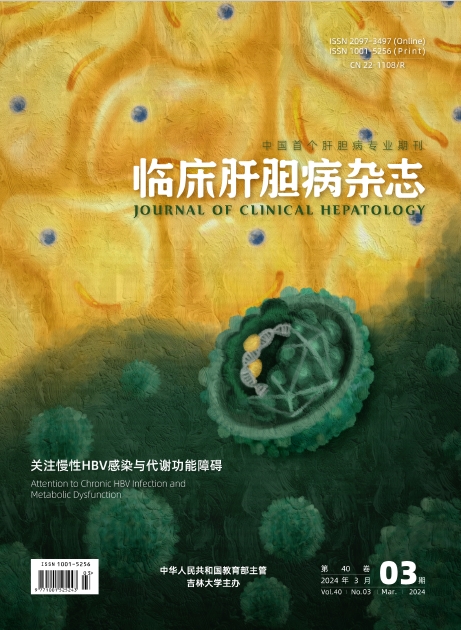| [1] |
TORRES S, ORTIZ C, BACHTLER N, et al. Janus kinase 2 inhibition by pacritinib as potential therapeutic target for liver fibrosis[J]. Hepatology, 2023, 77( 4): 1228- 1240. DOI: 10.1002/hep.32746. |
| [2] |
LI S, ZHOU B, XUE M, et al. Macrophage-specific FGF12 promotes liver fibrosis progression in mice[J]. Hepatology, 2023, 77( 3): 816- 833. DOI: 10.1002/hep.32640. |
| [3] |
XIA SL, LIU ZM, CAI JR, et al. Liver fibrosis therapy based on biomimetic nanoparticles which deplete activated hepatic stellate cells[J]. J Control Release, 2023, 355: 54- 67. DOI: 10.1016/j.jconrel.2023.01.052. |
| [4] |
LIU YW, DONG YT, WU XJ, et al. The assessment of mesenchymal stem cells therapy in acute on chronic liver failure and chronic liver disease: A systematic review and meta-analysis of randomized controlled clinical trials[J]. Stem Cell Res Ther, 2022, 13( 1): 204. DOI: 10.1186/s13287-022-02882-4. |
| [5] |
ZHANG ZL, SHANG J, YANG QY, et al. Exosomes derived from human adipose mesenchymal stem cells ameliorate hepatic fibrosis by inhibiting PI3K/Akt/mTOR pathway and remodeling choline metabolism[J]. J Nanobiotechnology, 2023, 21( 1): 29. DOI: 10.1186/s12951-023-01788-4. |
| [6] |
ZHAO T, SU ZP, LI YC, et al. Chitinase-3 like-protein-1 function and its role in diseases[J]. Signal Transduct Target Ther, 2020, 5( 1): 201. DOI: 10.1038/s41392-020-00303-7. |
| [7] |
YANG H, ZHAO LL, HAN P, et al. Value of serum chitinase-3-like protein 1 in predicting the risk of decompensation events in patients with liver cirrhosis[J]. J Clin Hepatol, 2023, 39( 7): 1578- 1585. DOI: 10.3969/j.issn.1001-5256.2023.07.011. |
| [8] |
MA L, WEI J, ZENG Y, et al. Mesenchymal stem cell-originated exosomal circDIDO1 suppresses hepatic stellate cell activation by miR-141-3p/PTEN/AKT pathway in human liver fibrosis[J]. Drug Deliv, 2022, 29( 1): 440- 453. DOI: 10.1080/10717544.2022.2030428. |
| [9] |
NISHIMURA N, DE BATTISTA D, MCGIVERN DR, et al. Chitinase 3-like 1 is a profibrogenic factor overexpressed in the aging liver and in patients with liver cirrhosis[J]. Proc Natl Acad Sci U S A, 2021, 118( 17): e2019633118. DOI: 10.1073/pnas.2019633118. |
| [10] |
WANG CG, LI SZ, SHI JM, et al. Research progress in differentiation, identification, and purification methods of human pluripotent stem cells to mesenchymal-like cells in vitro[J]. J Jilin Univ Med Ed, 2023, 49( 6): 1655- 1661. DOI: 10.13481/j.1671-587X.20230634. |
| [11] |
LI TT, WANG ZR, YAO WQ, et al. Stem cell therapies for chronic liver diseases: Progress and challenges[J]. Stem Cells Transl Med, 2022, 11( 9): 900- 911. DOI: 10.1093/stcltm/szac053. |
| [12] |
YANG X, LI Q, LIU WT, et al. Mesenchymal stromal cells in hepatic fibrosis/cirrhosis: From pathogenesis to treatment[J]. Cell Mol Immunol, 2023, 20( 6): 583- 599. DOI: 10.1038/s41423-023-00983-5. |
| [13] |
ZHAO SX, LIU Y, PU ZH. Bone marrow mesenchymal stem cell-derived exosomes attenuate D-GaIN/LPS-induced hepatocyte apoptosis by activating autophagy in vitro[J]. Drug Des Devel Ther, 2019, 13: 2887- 2897. DOI: 10.2147/DDDT.S220190. |
| [14] |
LEE CG, HARTL D, LEE GR, et al. Role of breast regression protein 39(BRP-39)/chitinase 3-like-1 in Th2 and IL-13-induced tissue responses and apoptosis[J]. J Exp Med, 2009, 206( 5): 1149- 1166. DOI: 10.1084/jem.20081271. |
| [15] |
HIGASHIYAMA M, TOMITA K, SUGIHARA N, et al. Chitinase 3-like 1 deficiency ameliorates liver fibrosis by promoting hepatic macrophage apoptosis[J]. Hepatol Res, 2019, 49( 11): 1316- 1328. DOI: 10.1111/hepr.13396. |














 DownLoad:
DownLoad:

